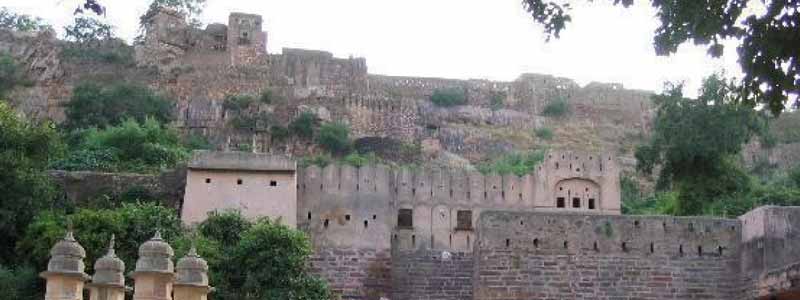Why is Ranthambore famous?, located in Rajasthan, India, is renowned for its wildlife sanctuary, historical significance, and breathtaking landscapes. The Ranthambore National Park, a major tiger reserve, is famous for its population of majestic Bengal tigers, offering rare opportunities to spot these big cats in their natural habitat. Alongside tigers, the park is home to diverse wildlife, including leopards, sloth bears, deer, and over 300 bird species.
The Ranthambore Fort, a UNESCO World Heritage Site, adds a historical dimension. Built in the 10th century, this fort is known for its ancient temples, palaces, and strategic importance in Rajasthan’s history.
Ranthambore’s picturesque terrain, featuring tranquil lakes, rocky cliffs, and dense forests, enhances its allure for nature lovers and photographers. The park is also a conservation hub under Project Tiger, showcasing successful wildlife preservation efforts.
Easily accessible and rich in cultural and ecological treasures, Ranthambore is a top destination for adventure seekers, history enthusiasts, and eco-tourists.

History of Ranthambore Tiger Reserve
Ranthambore Tiger Reserve, located in Rajasthan, India, has a rich history intertwined with conservation and heritage. Initially established in 1955 as the Sawai Madhopur Game Sanctuary, it served as a hunting ground for the Jaipur royals. With the initiation of Project Tiger in 1973, Ranthambore was designated as one of the first nine tiger reserves in India, marking a significant shift from hunting to preservation.
The park’s name derives from the Ranthambore Fort, a 10th-century UNESCO World Heritage Site located within its boundaries, showcasing the area’s historical and cultural significance. The fort was once a stronghold for rulers and played a key role in regional defense.
Over the decades, Ranthambore became a symbol of successful tiger conservation. Despite challenges like poaching and habitat loss, focused efforts, including anti-poaching measures and eco-tourism initiatives, have helped stabilize the tiger population, Why is Ranthambore famous?.
Today, Ranthambore stands as a beacon of India’s conservation success, blending history, wildlife, and natural beauty.

Great Tiger & Wildlife Sightings
Ranthambore National Park, a jewel of Rajasthan, is celebrated for exceptional tiger and wildlife sightings, making it a favorite destination for nature enthusiasts and photographers. The park is renowned for its thriving population of Bengal tigers, offering a high probability of spotting these majestic predators during daylight safaris. Iconic tigers like Machli, known as the “Queen of Ranthambore,” and her descendants have captivated visitors with their bold appearances near lakes and ruins.
In addition to tigers, Ranthambore’s diverse wildlife includes leopards, sloth bears, hyenas, and jackals, alongside herbivores like sambar deer, chital, and nilgai. The park’s numerous water bodies, such as Padam Talao and Rajbagh Talao, attract wildlife and create scenic backdrops for sightings.
Birdwatchers also delight in over 300 bird species, including peacocks, eagles, and parakeets. The park’s varied terrain of forests, grasslands, and cliffs ensures exciting encounters with its vibrant ecosystem, offering unforgettable experiences for wildlife enthusiasts, Why is Ranthambore famous?.

Ranthambore Tourist Attractions
Ranthambore in Rajasthan offers a mix of wildlife, history, and natural beauty, making it a top destination for travelers. The Ranthambore National Park is its crown jewel, renowned for Bengal tiger sightings, along with leopards, sloth bears, and over 300 bird species. The park’s tranquil lakes like Padam Talao, Rajbagh Talao, and Malik Talao attract wildlife and enhance the scenic beauty.
The majestic Ranthambore Fort, a UNESCO World Heritage Site, is a must-visit. Perched on a hill, it boasts ancient temples like the Trinetra Ganesh Temple, grand gateways, and panoramic views of the park. Nearby, the Jogi Mahal, situated by Padam Talao, adds historical charm, Why is Ranthambore famous?.
Other attractions include Surwal Lake for birdwatching and Kachida Valley, known for its leopard population. Nature lovers can also explore the Rajiv Gandhi Regional Museum of Natural History, showcasing biodiversity.
Ranthambore’s blend of wildlife, history, and serenity promises an unforgettable experience.

Places to Visit Around Ranthambore
Ranthambore’s surrounding region offers a mix of historical, cultural, and natural attractions, making it a versatile destination for travelers.
- Ranthambore Fort: A UNESCO World Heritage Site located within the national park, the fort features ancient temples, palaces, and stunning views of the park.
- Khandar Fort: Situated about 40 km from Ranthambore, this historic fort is known for its strategic location and intricate architecture.
- Surwal Lake: A serene spot ideal for birdwatching, especially during the migratory season, located 25 km from the park.
- Trinetra Ganesh Temple: Situated inside the Ranthambore Fort, this temple is one of the oldest and most revered Ganesha temples in India.
- Padam Talao: A picturesque lake within Ranthambore, often frequented by wildlife, including crocodiles and deer.
- Chauth Mata Temple: Located 35 km away, this hilltop temple is a significant pilgrimage site offering panoramic views.
These nearby attractions complement the wildlife and natural beauty of Ranthambore, enhancing your travel experience.
The Most Memorable Wildlife Photography Experience
Wildlife photography is a thrilling blend of patience, skill, and luck, where each moment offers a chance to capture nature’s raw beauty. Among the countless experiences one could have, a truly memorable one often involves an unexpected, intimate encounter with the wild, Why is Ranthambore famous?.
Imagine being in the heart of Ranthambore National Park, camera poised, as the golden light of dawn filters through the forest. Suddenly, a tiger emerges from the dense foliage, its majestic stripes blending seamlessly with the dappled shadows. As it approaches a waterhole, you capture the moment it pauses to drink, the water rippling around its reflection—a perfect harmony of predator and serenity.
Alternatively, picture the thrill of documenting a mother elephant and her calf at a watering hole in the African savanna, their playful interaction against the backdrop of a fiery sunset. Or the delicate dance of a hummingbird hovering over a vibrant flower in the Amazon rainforest.
These experiences are unforgettable, not just for the stunning shots but for the profound connection with nature they inspire, Why is Ranthambore famous?.








